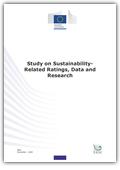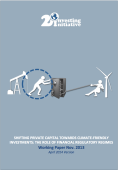This report provides a global framework and recommends an integrated energy approach, defined as “systemic efficiency”, as a solution to the current environmental, economic, health, and social crises.
This brief utilises econometric analysis to illustrate how the implementation of the SDGs is a statistically significant variable in a country’s improved performance in the Ease of Doing Business Index which, in turn, can aid in building back better as the world enters the second year of the pandemic.
The purpose of this learning brief is to share lessons and insights on how climate-related investments can support countries’ COVID-19 recovery efforts, drawing on recent evidence and experience in the Climate Investment Funds (CIF).

This study describes the state of play of the sustainability-related products and services market; establishes an inventory and classification of market actors, sustainability products and services available in the market; and analyses the use and quality of sustainability-related products and services by market participants. The study explores how the reliability and quality of assessment of sustainability-related data, ratings and research by third party providers can be enhanced and provides recommendations to stimulate demand and improve the quality of supply.

Part of the challenge of implementing green financial regulation is that there is currently very little analysis on green financial regulatory incentives. A crucial condition for achieving the 2° climate target is mobilizing capital for green investment. One estimate suggests a necessary cumulative investment of $36-$42 tn until 2030, or the equivalent of roughly $2 tn annually, to realize climate targets. Current investment levels however are only roughly $359 bn annually, giving rise to a 'green investment gap'. This study constitutes the first comprehensive overview of the range of instruments available to policymakers to align the financial sector with 2°investment scenarios.
